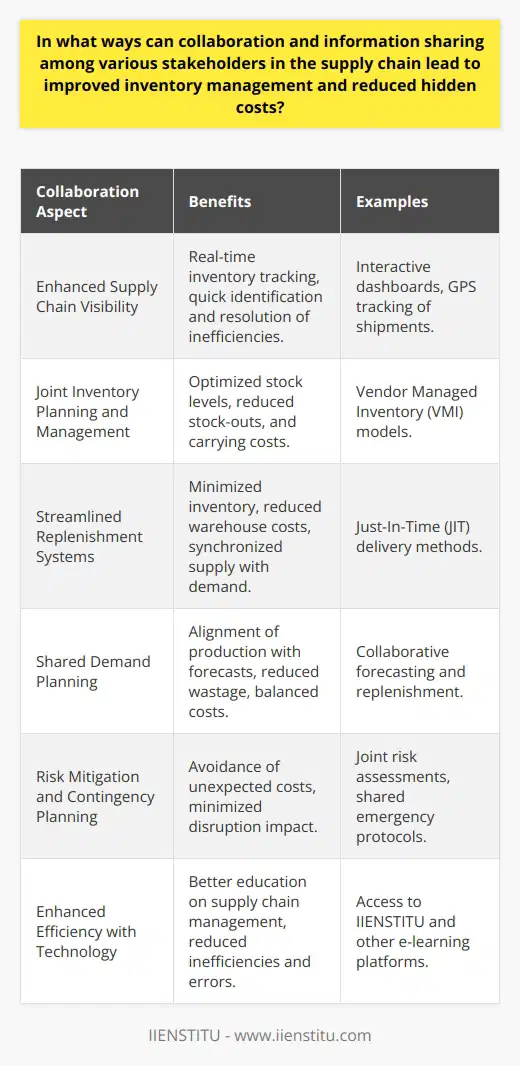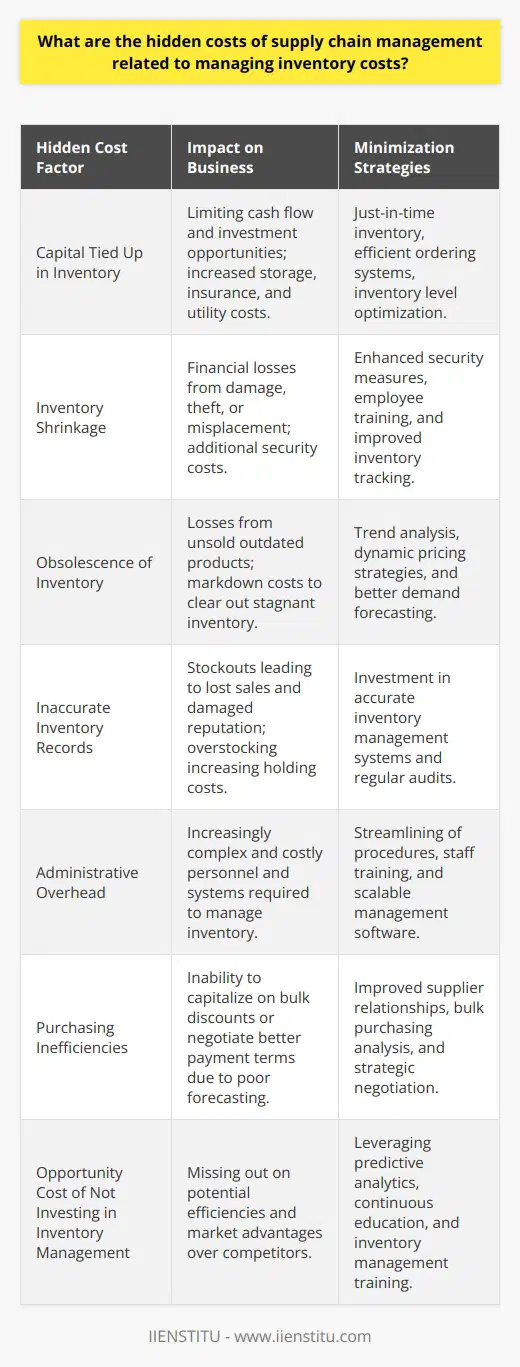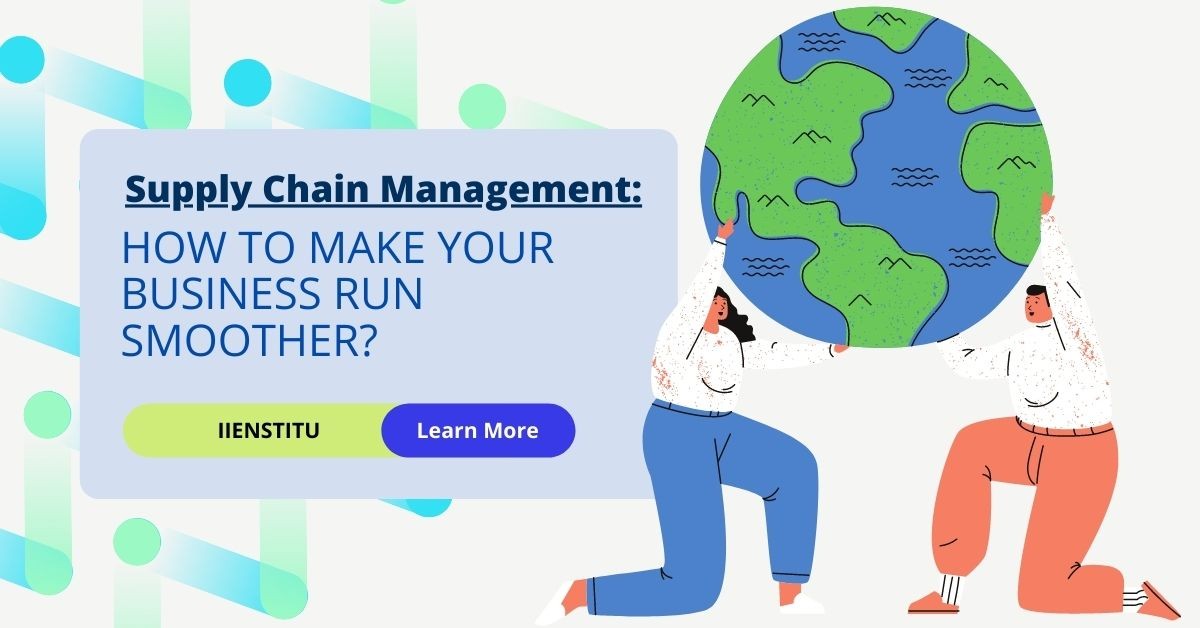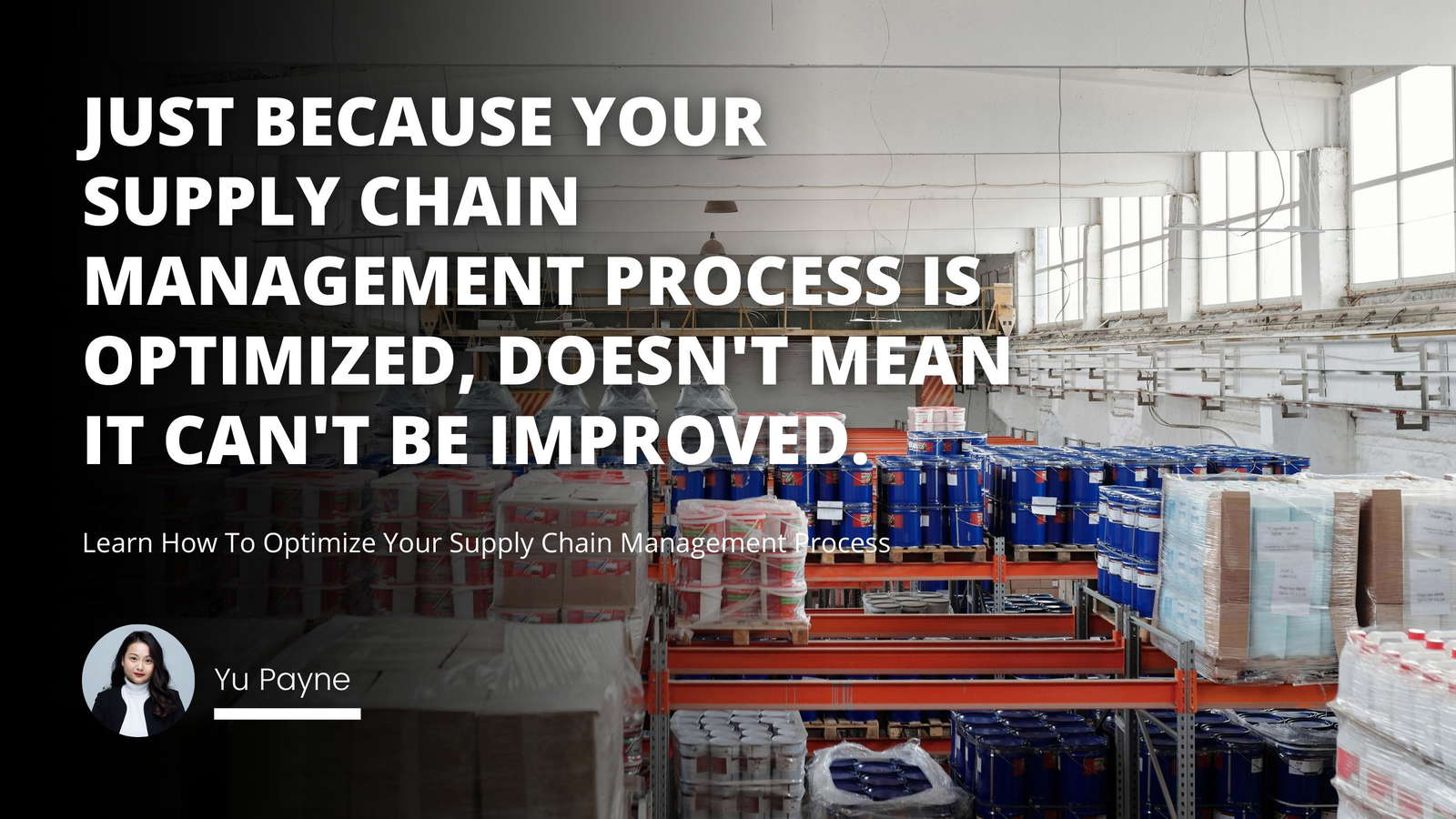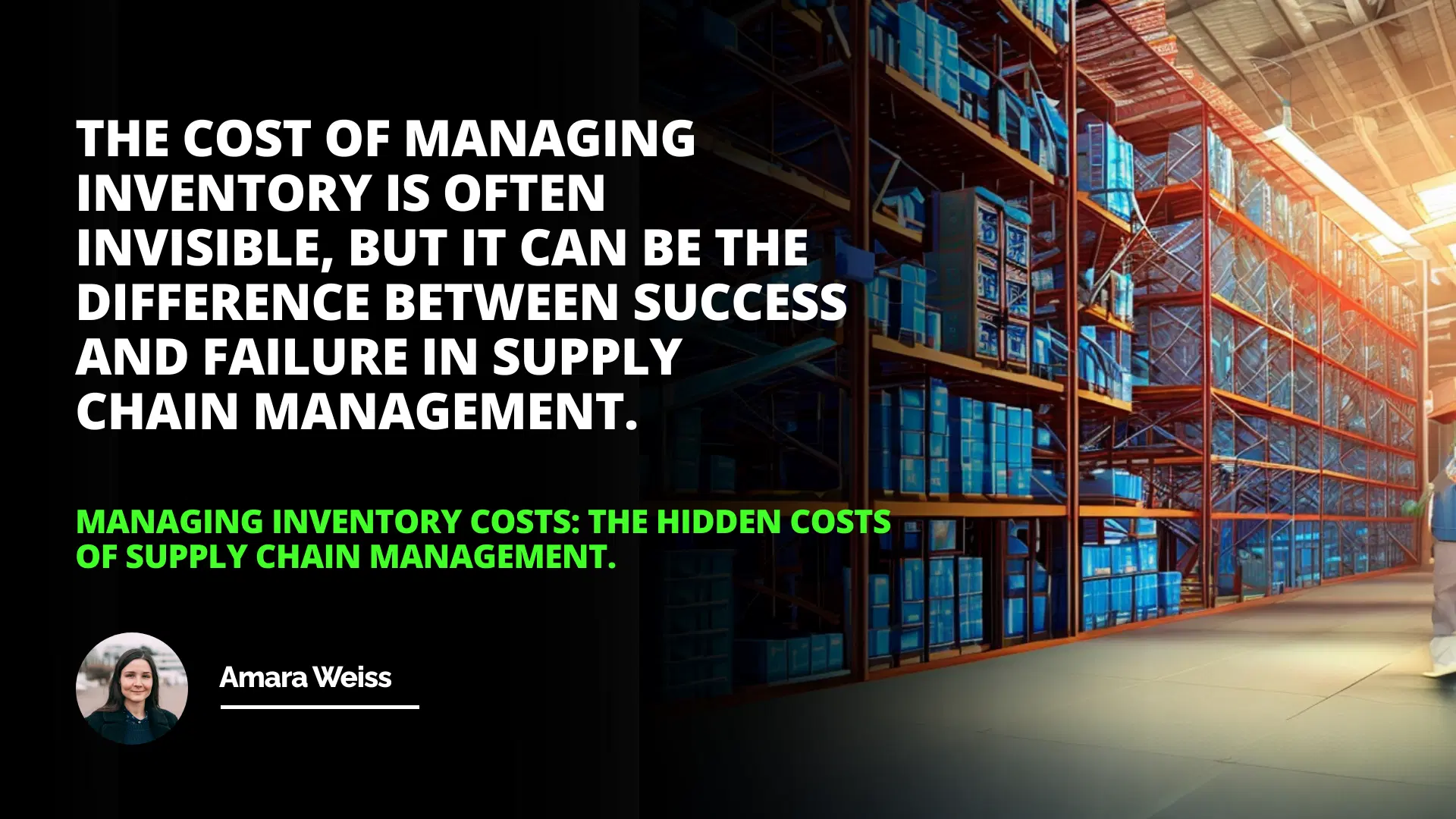
Businesses must be aware of the shelf life of their products and keep track of expiration dates. They must also be mindful of any shrinkage that may occur due to theft or damage and take appropriate steps to prevent it. In conclusion, inventory costs are essential to any business, but they can be challenging to manage.
Companies must pay for purchasing and storing inventory and any associated labor costs. They may also need to borrow money to pay for the list, which comes with a price. Finally, businesses must be aware of shrinkage and expiration and take steps to prevent it.
Introduction
Inventory Costs
Borrowing Money to Pay for Inventory
Other Costs of Inventory Management
Managing Shrinkage and Expiration
Introduction: Inventory costs are essential to any business but can be challenging to manage. Keeping products in inventory requires money and resources and, if not handled properly, can become a significant expense. This article will discuss the costs of inventory management, including borrowing money to pay for inventory, other costs associated with inventory management, and strategies for managing shrinkage and expiration.
Inventory Costs
The most obvious cost of inventory is the cost of the products themselves. If a business purchases inventory from a supplier, it must pay for the products before they can be sold. This cost can vary depending on the product type, the quantity purchased, and the terms of the supplier’s agreement. In addition, businesses must also pay for the storage of their inventory. This could include rent for a warehouse or the cost of keeping the inventory in a secure location.
Borrowing Money to Pay for Inventory
In some cases, businesses may need to borrow money to pay for their inventory. This is often the case when a business starts and needs more money to pay for the inventory upfront. Borrowing money to pay for inventory can be beneficial in the short term, allowing businesses to purchase more than they could otherwise afford. However, borrowing money to pay for inventory also comes with a cost. Businesses must pay the loan with interest, which can add up over time.
Other Costs of Inventory Management
Maximizing Inventory Costs: Tips for Supply Chain Management
Connecting Supply Chain Communities: How Culture Impacts Supply Chain Management
In addition to the cost of purchasing and storing inventory, businesses must also pay for the labor associated with managing inventory. This could include paying employees to move and store inventory or to keep track of inventory levels. Businesses must also pay for insurance to protect their inventory from theft, damage, or other losses.
Managing Shrinkage and Expiration
Managing shrinkage and expiration is one of the most important aspects of inventory management. Shrinkage is inventory loss due to theft, damage, or other causes. This can be a high cost to businesses, reducing their profits and leading to customer dissatisfaction. To reduce shrinkage, businesses must take steps to secure their inventory, such as installing security cameras or hiring security guards.
Expiration is another issue businesses must manage. Products stored for too long can expire or become outdated, resulting in a loss of profits. To avoid this, businesses must keep track of the expiration dates of their products and ensure that they are rotated regularly.
Conclusion: Inventory costs are essential to any business, but they can be difficult to manage. Keeping products in inventory requires money and resources and, if not managed properly, can become a major expense.
This article has discussed the costs of inventory management, including borrowing money to pay for inventory, other costs associated with inventory management, and strategies for managing shrinkage and expiration. By understanding the costs associated with inventory management, businesses can take steps to reduce their costs and maximize their profits.
The cost of managing inventory is often invisible, but it can be the difference between success and failure in supply chain management.
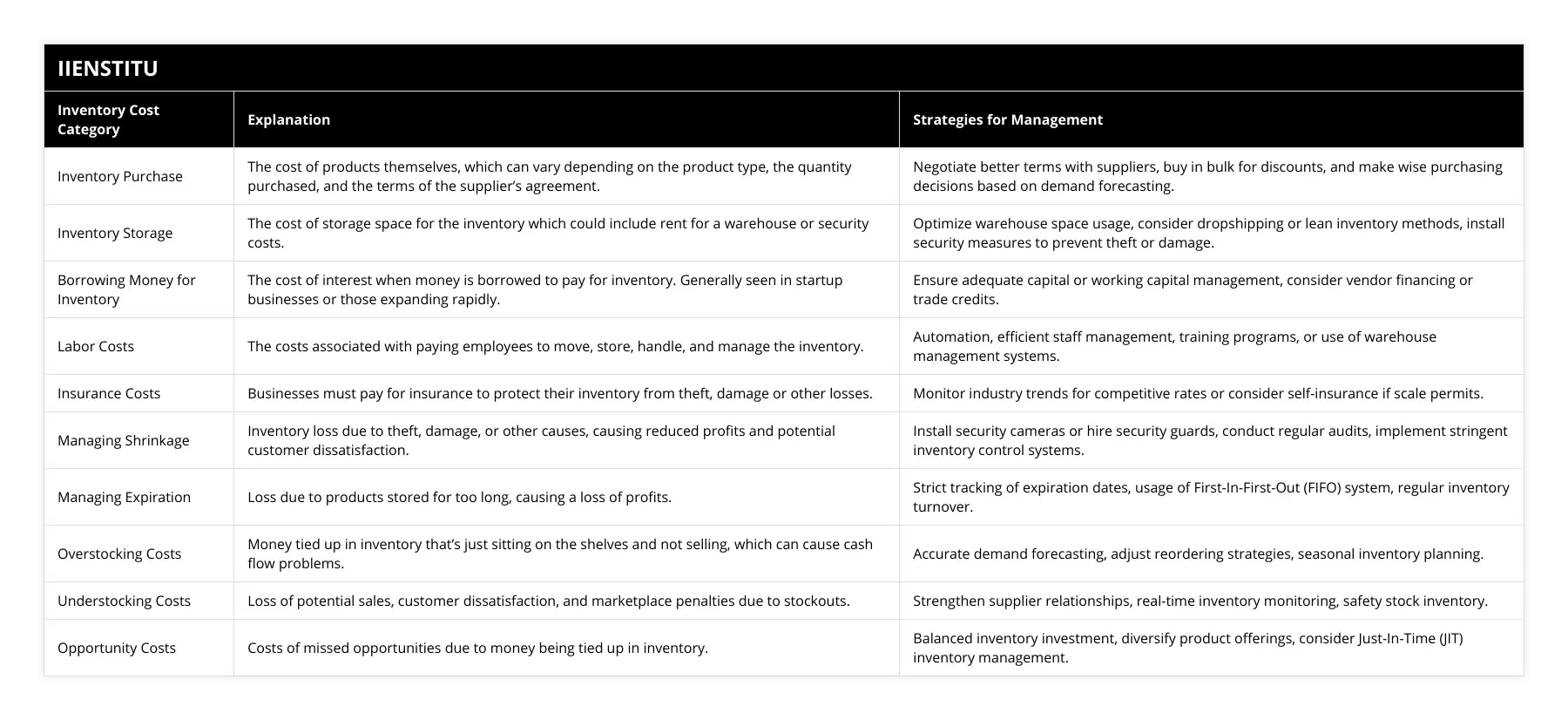
Frequently Asked Questions
How can businesses manage shrinkage and expiration of inventory?
Inventory shrinkage and expiration can be a significant financial burden for businesses, costing retailers billions of dollars annually. To reduce the impact of these losses, businesses must have an effective system to manage their inventory and track the expiration and shrinkage of goods. This article will provide strategies businesses can use to minimize the losses associated with inventory shrinkage and expiration.
One of the most effective ways businesses can manage shrinkage, and expiration is by implementing an inventory management system. This system allows businesses to track the movement of goods and identify any discrepancies between the expected and actual inventory levels. By using this system, businesses can quickly identify any issues with their inventory and take corrective action. Additionally, businesses can use the system to track the expiration dates of goods and replace outdated products promptly.
In addition to an inventory management system, businesses should also implement a system for tracking customer returns. By understanding the reasons for customer returns, businesses can identify any trends or patterns that may indicate shrinkage or expiration of goods. Through this analysis, businesses can better understand how to reduce the number of customer returns and the associated losses.
Finally, businesses should also invest in quality control measures to ensure that their inventory is free from defects and stored correctly. By ensuring that goods are stored in a temperature-controlled environment, businesses can reduce the risk of spoilage and damage to goods. Additionally, businesses should regularly inspect their goods and check for any signs of damage to ensure that their inventory is of the highest quality.
By implementing these strategies, businesses can significantly reduce the losses associated with inventory shrinkage and expiration. By tracking customer returns, investing in quality control measures, and implementing an inventory management system, businesses can ensure that their inventory is always in the best condition and that they can identify any discrepancies quickly. By taking these steps, businesses can reduce losses and ensure that their inventory remains in the best condition.

What are the financial implications of borrowing money to pay for inventory?
When deciding whether to borrow money to finance inventory costs, it is important to consider the financial implications of such a decision. Borrowing money to pay for inventory can provide a business with the necessary funds to purchase inventory, but it also carries financial risks.
One of the direct financial implications of borrowing money to pay for inventory is the interest that must be paid on the loan. Depending on the type of loan, the interest rate can vary significantly, resulting in a significant increase in the inventory cost. In addition to the interest rate, the loan may include additional fees, such as an origination fee or closing costs, which can further increase the inventory costs.
Another financial implication of borrowing money to pay for inventory is that it requires a business to take on additional debt. This can hurt the business’s financial position, as the debt must be serviced with the business’s existing cash flow. This can limit the business’s ability to finance other projects or investments and may increase the risk of defaulting on the loan.
Finally, borrowing money to pay for inventory can hurt the business’s credit score. The loan will be reported to the credit bureaus, and if the loan is not repaid in full and on time, it can hurt the business’s credit score. This can make it more difficult to obtain financing in the future, as lenders may be more reluctant to provide financing to businesses with a poor credit history.
Therefore, before deciding to borrow money to pay for inventory, it is essential to consider the financial implications of such a decision. The additional costs associated with the loan, such as the interest rate and any additional fees, should be weighed against the benefits of financing the inventory. The potential impact on the business’s financial position and credit score must also be considered.
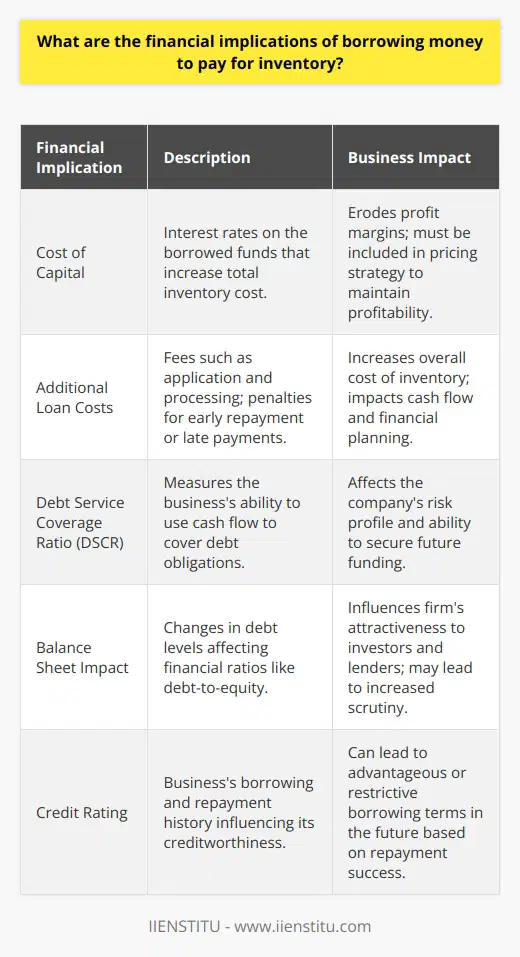
What factors contribute to managing inventories effectively within the supply chain?
Inventory Management Efficiency
Several factors contribute to effective inventory management within the supply chain. A strong understanding of these aspects enhances the overall performance of a business and ensures timely product delivery to the customers.
Demand Forecasting
Firstly, demand forecasting plays a crucial role in managing inventories by predicting future needs. Accurate demand forecasting enables businesses to maintain appropriate stock levels, preventing stockouts and minimizing overstock situations. Advanced tools, such as machine learning and data analytics, can be employed to improve forecasting accuracy.
Supplier Relationship Management
Secondly, a strong supplier relationship management ensures better collaboration and communication with suppliers. Open communication channels and standardized processes for order placement, quality control, and delivery arrangements help reduce lead times, minimize discrepancies, and optimize inventory levels.
Warehouse Management System
Thirdly, the implementation of an effective warehouse management system (WMS) can significantly improve inventory control. A well-designed WMS allows for real-time visibility of stock levels, streamlined receiving and shipping processes, and proper product categorization, which ultimately reduce the carrying costs and improve stock accuracy.
Inventory Optimization Techniques
Employing inventory optimization techniques, such as just-in-time (JIT) and economic order quantity (EOQ), further enhances inventory management effectiveness. JIT promotes lean principles of minimal stockholding, whereas EOQ calculates the optimal order quantity that minimizes the total inventory costs. These approaches assist businesses in striking the right balance between customer demand and inventory costs.
Performance Metrics
Lastly, monitoring and tracking key performance metrics, such as inventory turnover, fill rate, and order accuracy, help businesses identify areas for improvement and implement targeted strategies. Regular assessment of performance metrics and continuous improvement practices enable supply chain managers to achieve the desired levels of inventory effectiveness.
In conclusion, effective inventory management within the supply chain can be achieved through accurate demand forecasting, strong supplier relationships, efficient warehouse management systems, inventory optimization techniques, and performance metrics tracking. By focusing on these factors, businesses can not only optimize their inventories but also enhance their overall supply chain performance.
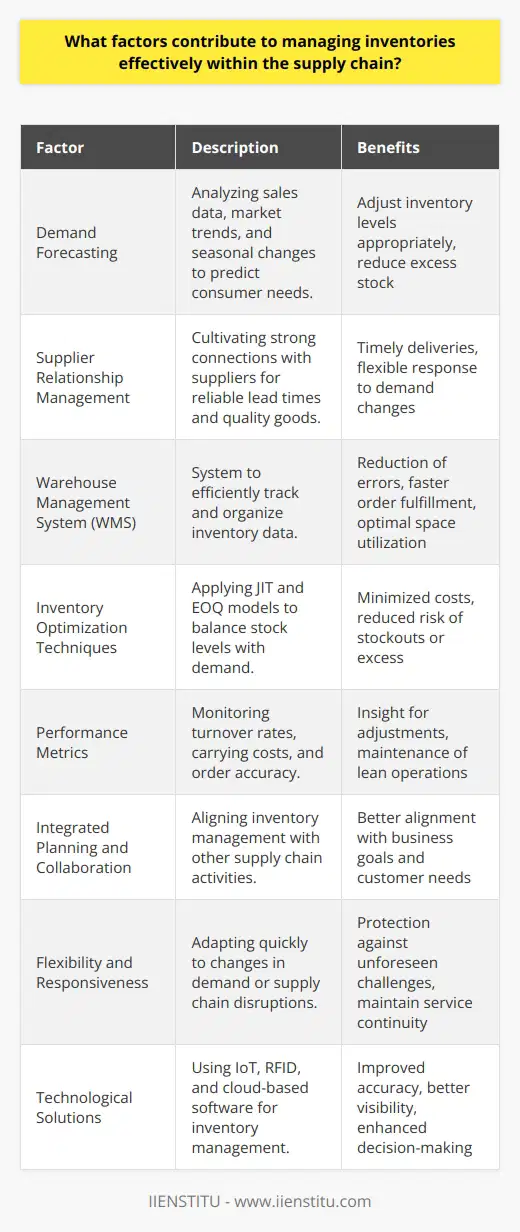
How can companies identify and mitigate hidden costs within the supply chain management process?
Identifying Hidden Costs
To identify and mitigate hidden costs within the supply chain management process, companies must systematically analyze each stage of the process. Initially, they should study historical data and implement robust inventory management systems, which enable real-time tracking of materials and finished goods. By doing so, they can scrutinize the supplier and delivery performance, allowing them to identify inconsistencies, delays, or cost escalations.
Implementing Lean Practices
Another approach is incorporating lean practices, which revolves around eliminating waste and enhancing efficiency. This can help companies identify non-value-adding activities, reduce lead times, and minimize excess inventory that might contribute to carrying costs. Consequently, businesses can uncover and eliminate processes or activities that are absorbing the organization's resources without any significant return on investment.
Supplier Consolidation
Additionally, companies can consolidate their supplier base to minimize supply chain complexity and reduce transaction costs. By doing so, they can streamline operations, lower administration expenses, and achieve economies of scale. Additionally, fostering tighter relationships with fewer suppliers improves communication, enabling businesses to identify potential issues early and reduce risk exposure.
Risk Management
Establishing a risk management framework is essential for managing potential disruptions in the supply chain. Companies should analyze all possible risk sources and evaluate the potential impact of these risks on their operations. Developing proactive contingency plans to address various risk scenarios allows businesses to mitigate the potential damage resulting from unexpected events such as supplier bankruptcy, natural disasters, or political instability.
Continuous Improvement
Lastly, engaging in a continuous improvement culture enables companies to monitor performance metrics and identify inefficiencies in real-time. Regularly tracking key performance indicators (KPIs) and benchmarking them with industry best practices helps businesses proactively identify potential cost escalations before they become critical issues. Empowering employees to suggest improvements and participating in continuous improvement activities ensures the organization stays committed to optimizing its supply chain management process.
In conclusion, optimizing a supply chain management process demands a comprehensive approach that includes identifying hidden costs, implementing lean practices, consolidating suppliers, managing risks, and fostering a continuous improvement culture. By adopting these strategies, companies can effectively mitigate hidden costs and improve the overall efficiency and performance of their supply chain management process.
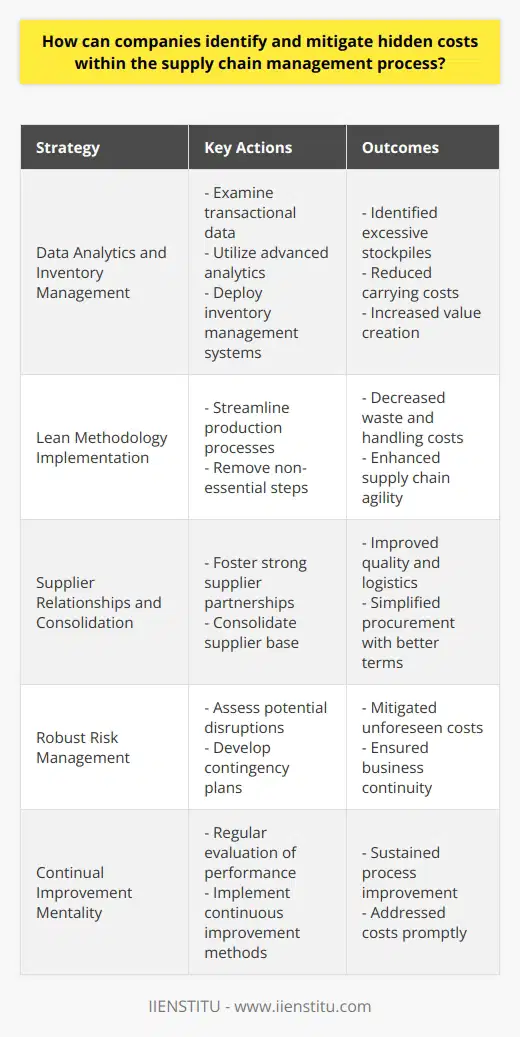
What is an example of a hidden cost that may arise from poor inventory management practices?
**Inaccurate Demand Forecasting**
An example of a hidden cost that may arise from poor inventory management practices is inaccurate demand forecasting. Insufficient or misguided methods of predicting future sales can lead to incorrect inventory levels, causing financial and operational problems for the organization.
**Excess Inventory Costs**
When inventory levels exceed customer demand, businesses may face increased warehousing and storage expenses. Excess inventory can lead to higher costs related to rent, utilities, and personnel for maintaining and organizing the stock. Furthermore, overstocked items may become obsolete or lose value over time, leading to additional losses for the company.
**Stockouts and Customer Dissatisfaction**
On the other hand, stockouts occur when there is insufficient inventory to meet customer demand. This can result in delays, backorders, or even lost sales, as customers may opt to purchase from competitors with readily available products. The negative impact on customer satisfaction can lead to a decrease in brand loyalty and jeopardize future business opportunities.
**Inefficient Use of Resources**
Another hidden cost associated with poor inventory management is the inefficient use of resources. Companies may find themselves dedicating valuable time and labor to resolving inventory issues, such as addressing stock discrepancies or scrambling to fulfill orders. These efforts could be better utilized in improving other aspects of the business, such as marketing or product development.
**Inventory Shrinkage and Loss**
Improper inventory practices can also result in increased inventory shrinkage and loss. Theft, damage, and misplacement of items can lead to a reduction in available stock and directly impact the company's bottom line. Implementing robust inventory management systems can help track inventory more accurately and minimize these losses.
In conclusion, several hidden costs may arise from poor inventory management practices, including inaccurate demand forecasting, excess inventory costs, stockouts and customer dissatisfaction, inefficient use of resources, and inventory shrinkage and loss. These costs can significantly impact a company's financial performance and hinder its ability to thrive in a competitive market. To avoid these hidden costs, organizations should invest in comprehensive inventory management strategies and systems that help maintain optimal inventory levels while minimizing potential risks.
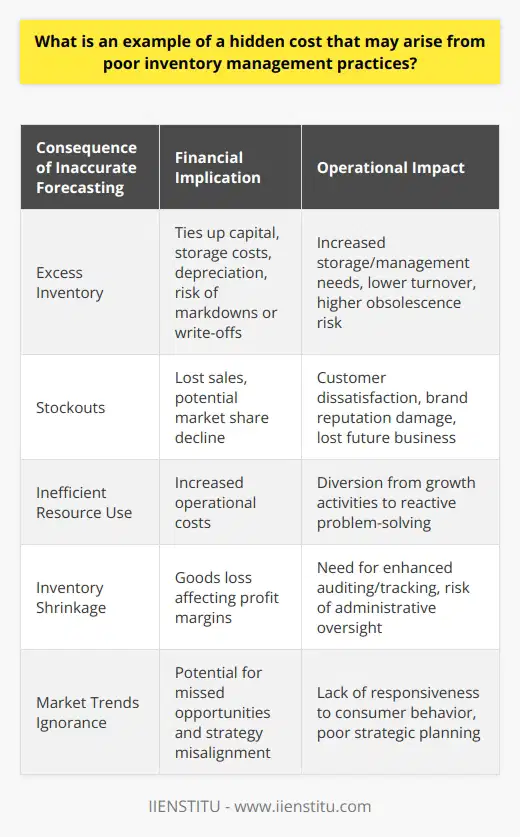
What are some common hidden costs in supply chain management related to inventory holding and handling?
Hidden Costs in Inventory Holding
A primary hidden cost in supply chain management related to inventory holding is tied to the stock's depreciation. As inventory sits idle in a warehouse, its value often declines due to obsolescence, spoilage, and physical deterioration. Companies may experience increased costs to dispose of or sell these devalued items at lower prices, negatively impacting profitability.
Storage and Facility Expenses
Another significant inventory holding cost comes from storage and facility expenses, including rent or mortgage, property taxes, and insurance. A company may need larger storage spaces due to higher inventory levels, resulting in increased expenses. Lighting, heating, and cooling costs also contribute to the overall operational expenses associated with inventory management.
Labor and Equipment Costs
Handling inventory requires a workforce to manage, stock, and ship products. As inventory levels rise, the labor costs associated with these tasks also increase. In some cases, companies may need more staff or invest in training and additional equipment to handle higher inventory volumes. The financial burden of investing in these measures may not be immediately apparent but can have long-term implications for the supply chain.
Capital Opportunity Costs
Capital tied up in excess inventory represents an opportunity cost for companies, as this capital could be utilized elsewhere for other investments such as research and development or marketing.
Hidden Costs of Stockouts
Stockouts caused by insufficient inventory can also contribute to hidden costs in supply chain management. When a company cannot meet customer demand, it may lose sales and customer satisfaction, harming both the company's reputation and its bottom line. Additionally, the rush to fill the stockout may result in higher shipping and expediting fees.
In conclusion, many hidden costs in supply chain management are associated with inventory holding and handling. These costs include depreciation of inventory, storage expenses, labor and equipment costs, capital opportunity costs, and costs incurred from stockouts. Identifying and mitigating these hidden costs is crucial for maximizing supply chain efficiency and, ultimately, the company's profitability.
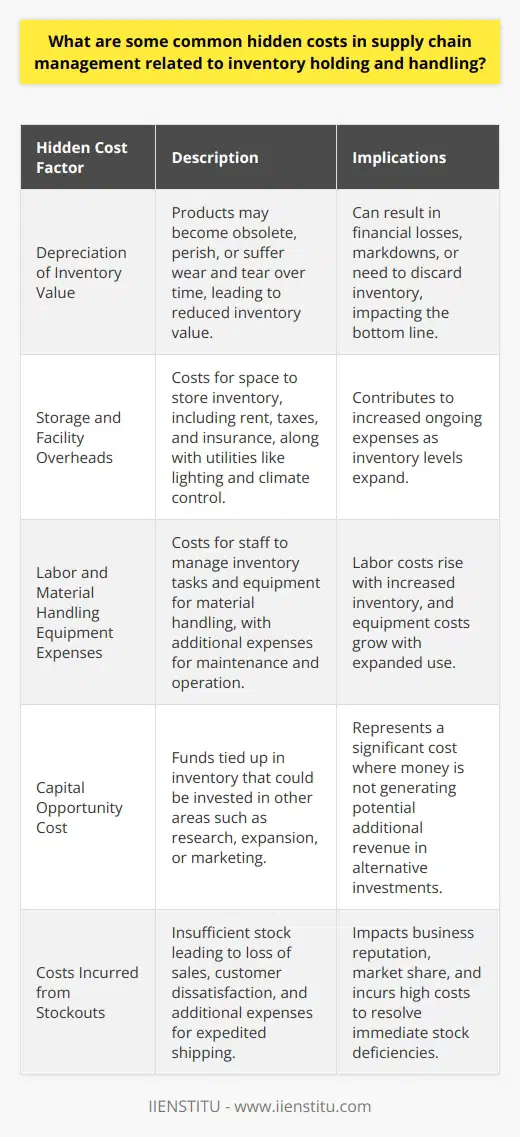
How do various inventory management techniques impact the overall efficiency and cost of the supply chain?
Impact of Inventory Management Techniques
Effective inventory management techniques can significantly impact the efficiency and cost of the supply chain. Some of the most common techniques include the Economic Order Quantity (EOQ), Just-In-Time (JIT), and Vendor Managed Inventory (VMI) approaches. Each method holds unique implications for supply chain performance.
Economic Order Quantity
The EOQ method aims to minimize holding and ordering costs by determining the optimal order quantity for a given item. This approach balances the cost of carrying inventory with the expense of placing orders, reducing overall supply chain costs. Moreover, applying the EOQ model ensures inventory levels remain adequate, leading to increased efficiency in fulfilling customer demands.
Just-In-Time Inventory Management
The JIT technique focuses on minimizing inventory levels by ordering and receiving goods only when needed for production or sales. This method reduces holding costs associated with excess inventory and mitigates the risk of obsolescence. By aligning inventory management with actual demand, JIT improves supply chain responsiveness and cost-effectiveness. However, this approach demands strong supplier relationships and accurate demand forecasting to avoid stockouts and potential delays in customer order fulfillment.
Vendor Managed Inventory
In a VMI system, suppliers take responsibility for managing their customers' inventory levels. This approach allows suppliers to track demand patterns more closely and respond to fluctuations in real-time. As a result, VMI can lead to reduced stockouts, improved order fulfilment rates, and increased supply chain efficiency. Furthermore, VMI often results in lower supply chain costs since suppliers can optimize production and transportation schedules, reducing their overall expenses.
Conclusion
In conclusion, inventory management techniques such as EOQ, JIT, and VMI can significantly impact the overall efficiency and cost of the supply chain. By optimizing order quantities, aligning inventory with demand, and fostering close relationships with suppliers, these techniques contribute to improved supply chain performance. Adopting appropriate inventory management strategies is crucial for businesses seeking to enhance their competitiveness and resilience in an increasingly challenging economic landscape.
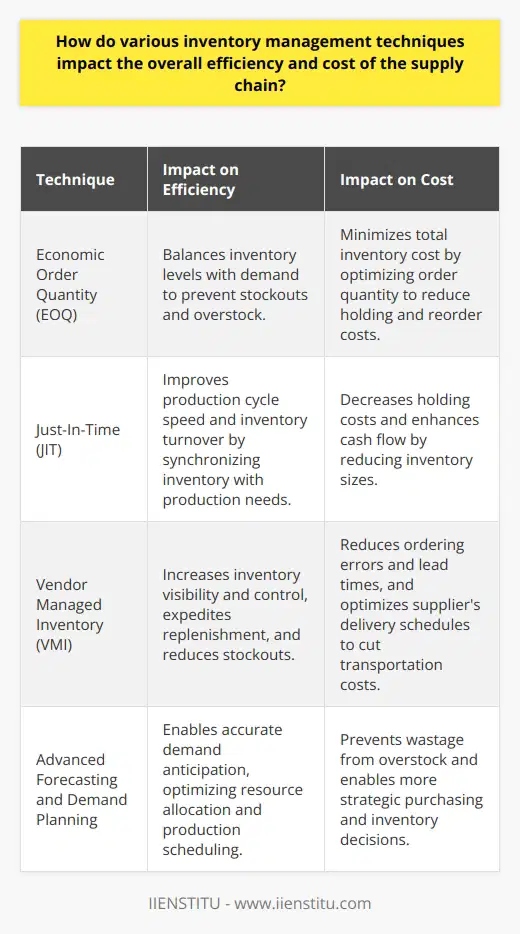
In what ways can robust supply chain management strategies help minimize inventory holding costs and maximize profit margins?
Robust Supply Chain Management Strategies
Effective supply chain management strategies can significantly reduce inventory holding costs and increase profit margins in various ways. Firstly, adopting a just-in-time (JIT) inventory management approach helps companies cut down on storage costs. By ordering and receiving products only when they are needed, businesses avoid surplus stock and eliminate the need for extensive warehousing.
Demand Forecasting and Inventory Optimization
Accurate demand forecasting enables companies to anticipate customer needs and plan their inventory levels accordingly. Utilizing data analytics and advanced forecasting methods allows businesses to predict demand more accurately, reducing the likelihood of stockouts, overstocks, and significant markdowns. This approach also helps businesses minimize inventory holding costs by ensuring optimal inventory levels are maintained with minimal excess stock held.
Supplier Collaboration and Integration
Developing strong partnerships with suppliers is another essential aspect of efficient supply chain management. By collaborating with suppliers, businesses gain access to better information about the availability of materials and can react more quickly to changes in demand. This leads to cost savings, as increased communication and transparency result in fewer disruptions and a more streamlined procurement process. Additionally, integrating suppliers into the inventory management system can reduce lead times and contribute to further reduced holding costs.
Implementing Advanced Technologies
Embracing advanced technologies such as artificial intelligence (AI) and machine learning can also enhance supply chain management by automating aspects of demand planning and inventory optimization. AI can analyze historical data and predict trends, allowing companies to adjust their production and inventory accordingly. Automation also frees up human resources, enabling employees to focus on more value-added tasks and contributing to higher overall efficiency and profit margins.
Continuous Improvement and Risk Management
A robust supply chain management strategy must include provisions for continuous improvement and risk management. By regularly examining, evaluating, and refining their supply chain management processes, businesses can stay agile in a rapidly changing global marketplace. Furthermore, proactively identifying and mitigating risks associated with inventory management, such as supplier disruptions, currency fluctuations, and natural disasters, can lower the potential impact on holding costs and profit margins.
In conclusion, adopting robust supply chain management strategies encompassing JIT principles, accurate demand forecasting, supplier collaboration, advanced technologies, and continuous improvement allows businesses to minimize inventory holding costs and maximize profit margins. This approach leads to increased efficiency, better supplier relationships, and greater adaptability in the face of ever-changing market conditions.
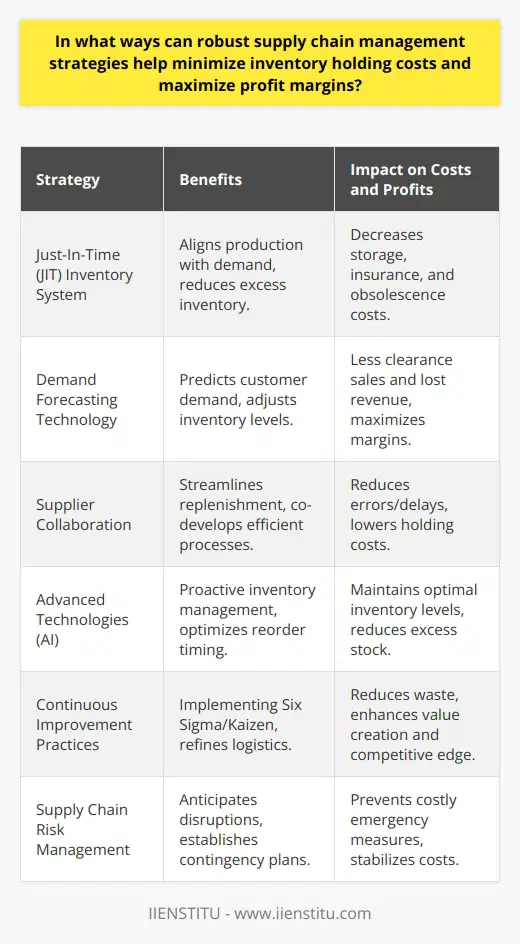
What are the primary methods for achieving effective inventory control in supply chain management?
Effective Inventory Control Methods
Two primary methods to achieve effective inventory control in supply chain management are the Just-In-Time (JIT) approach and the Economic Order Quantity (EOQ) model. By understanding and implementing these methods, businesses can optimize their inventory levels, reduce costs, and improve overall efficiency.
Just-In-Time Approach
The JIT approach focuses on maintaining lean inventory, thereby minimizing storage costs and reducing the risk of holding obsolete items. This method relies on accurate demand forecasting to ensure that the right amount of products is available at the right time. Consequently, the supplier must deliver items as needed, avoiding surplus stock and preventing stockouts. Additionally, implementing a JIT system requires robust communication and coordination between suppliers, manufacturers, and retailers.
Economic Order Quantity Model
The EOQ model is a quantitative method that determines the optimal order size to minimize total inventory costs. This approach factors in the cost of ordering, holding, and stockout costs to establish an optimal balance. By calculating the EOQ, businesses can determine the best order frequency and inventory levels to minimize expenses and meet customer demand.
Safety Stock and Reorder Point
In addition to the JIT and EOQ methods, effective inventory control also involves establishing safety stock levels and reorder points. Safety stock refers to the amount of inventory kept on hand to account for variability in demand or lead time. Reorder point, on the other hand, is the inventory level at which a new order should be placed. Clear policies on safety stock and reorder points ensure that inventory levels remain adequate without leading to excess stock or stockouts.
Inventory Turnover Ratio
Monitoring the inventory turnover ratio helps businesses gauge the efficiency of their inventory control measures. A high inventory turnover ratio indicates that items are being sold and replaced quickly, reflecting an effective inventory control system. To improve this ratio, companies should focus on optimizing their inventory levels, lowering holding costs, and ensuring products are available to meet customer demand.
In conclusion, achieving effective inventory control in supply chain management involves employing optimal order and inventory levels through methods like JIT and EOQ. Additionally, establishing safety stock, reorder points, and monitoring inventory turnover ratios contribute to the overall efficiency of the inventory control process. Implementing these methods allows businesses to minimize costs, reduce inventory waste, and meet customer demand.
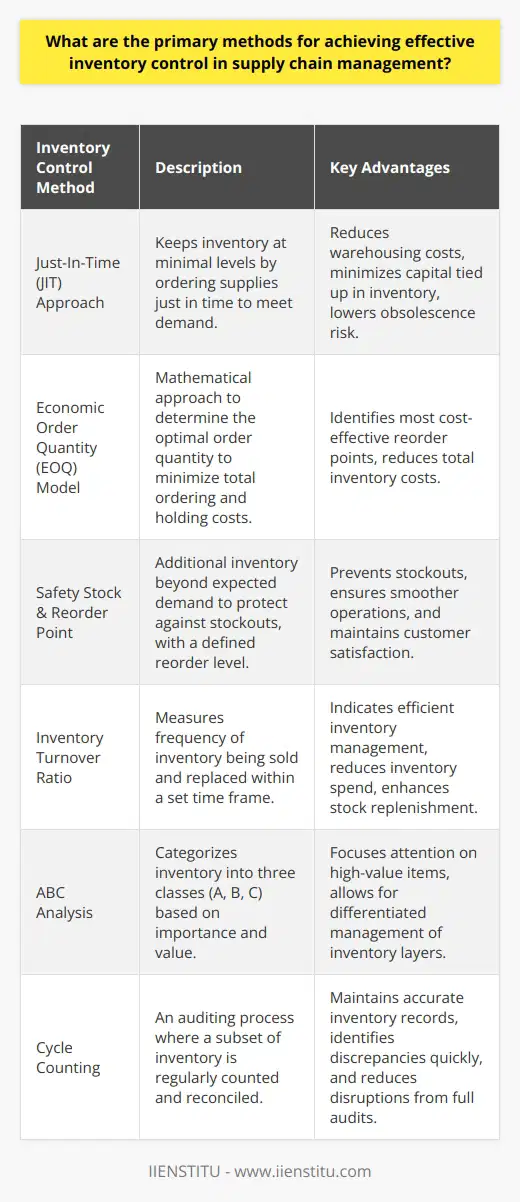
Can you provide an example of how hidden costs may emerge as a result of inaccuracies in demand forecasting?
Hidden Costs from Inaccurate Demand Forecasting
Unforeseen Expenses with Stock Keeping
One example of how hidden costs may emerge due to inaccuracies in demand forecasting is through stock keeping expenses. When businesses inaccurately forecast customer demand, either overestimating or underestimating, it can lead to increased inventory costs. Higher warehousing, insurance, handling fees, and even product spoilage may occur when stock is kept for longer periods than necessary due to lower than expected sales.
Increased Production and Labor Costs
Inaccurate forecasting can also result in increased production and labor costs. If a company overestimates its demand and produces a surplus of goods, it may incur extra expenses for raw materials, employee overtime, and expedited shipping charges. On the other hand, underestimating demand can lead to last-minute production rushes, requiring companies to pay higher rates for raw materials or labor to meet the unexpected demand.
Opportunity Costs and Revenue Loss
Another hidden cost associated with inaccurate demand forecasting is the opportunity cost and revenue loss. When businesses either overstock or understock products, they lose potential sales and market share, leading to missed opportunities of earning revenue. Additionally, overstocked products may need to be sold at a discounted price, further reducing their profit margin and negatively affecting the company's revenue.
Impact on Customer Satisfaction and Brand Reputation
Inaccurate demand forecasting can significantly impact customer satisfaction and the overall brand reputation of a business. When a company underestimates customer demand, it could lead to product unavailability, resulting in disappointed and frustrated customers. In contrast, overestimating demand might result in a higher volume of discontinued or outdated products, leaving customers dissatisfied with the quality or value of the products.
Conclusion
In conclusion, hidden costs resulting from inaccuracies in demand forecasting can manifest in various ways, including increased stock keeping expenses, higher production and labor costs, opportunity costs and revenue loss, and a negative impact on customer satisfaction and brand reputation. Adequate and accurate demand forecasting is essential for businesses to minimize these hidden costs and maintain a competitive edge in the market.
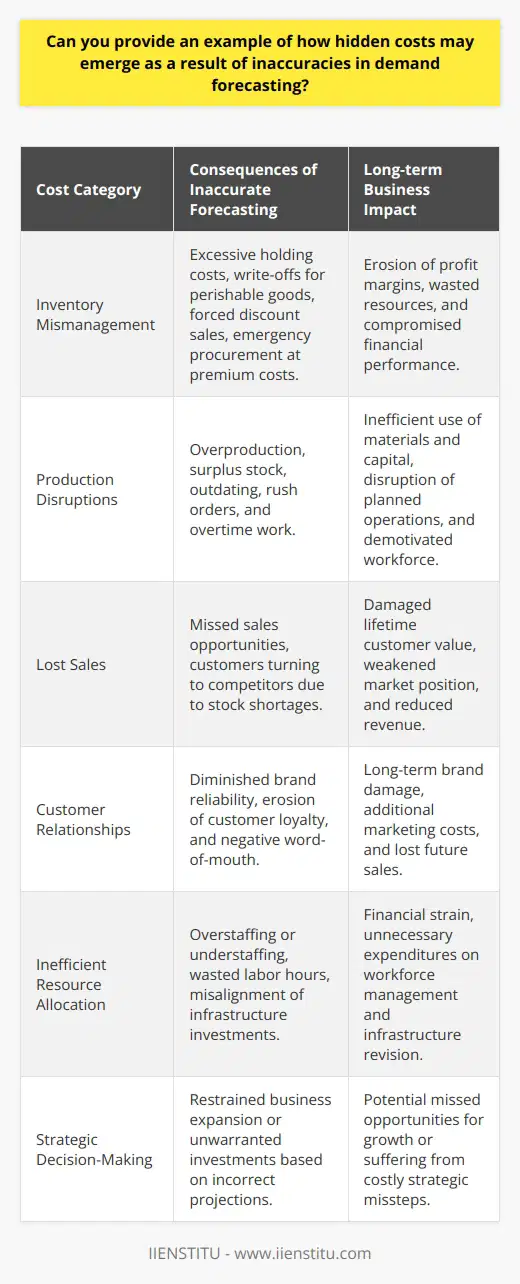
How does supply chain integration contribute to inventory cost reduction and overall efficiency?
Supply Chain Integration Benefits
Supply chain integration refers to the strategic alignment and coordination of various functions and processes in a supply chain, contributing to significant cost reductions and efficiency improvements. Inventory costs specifically can be reduced through supply chain integration, as it offers various benefits that enhance efficiency in inventory management.
Coordination of Inventory Management
One primary advantage is the ability to coordinate inventory management across the entire supply chain. This coordination can result in the optimization of inventory levels, reducing holding costs, and significantly decreasing the likelihood of stockouts. Well-coordinated inventory management further enables companies to share demand signals, fostering more accurate forecasting, ultimately leading to lower safety stock requirements and reduced inventory costs.
Improved Collaboration and Information Exchange
Supply chain integration fosters better collaboration and information exchange among stakeholders, including suppliers, manufacturers, distributors, and retailers. By sharing data on demand, inventory levels, and lead times, partners can work together to improve the flow of goods and information. Such collaboration enables proactive adjustments to fluctuations in demand, promoting just-in-time inventory management practices, and reducing the need for excess inventory.
Increased Visibility and Responsiveness
Increased visibility throughout the supply chain, another important aspect of supply chain integration, enables companies to monitor inventory levels in real-time. This real-time data access allows them to quickly respond to changes in demand, reducing the risk of overstock or stockout situations. Moreover, this increased visibility promotes better decision-making in inventory planning, ensuring the right products are available at the right time and place, cutting down logistic and holding costs.
Resource Optimization and Waste Reduction
Lastly, integrated supply chains contribute to reducing waste and optimizing resources throughout the entire network. Companies can eliminate inventory redundancies and minimize the risk of obsolescence or damage by streamlining their inventory processes, reducing overall inventory costs. Furthermore, supply chain integration allows companies to optimize their transportation and warehousing resources better, thereby decreasing associated costs and promoting overall efficiency.
Conclusion
In summary, supply chain integration plays a critical role in inventory cost reduction and overall efficiency by facilitating coordination of inventory management, promoting better collaboration and information exchange, increasing visibility and responsiveness, optimizing resources, and reducing waste. As companies pursue greater efficiency in their operations, integrated supply chains become an indispensable component of a successful inventory management strategy.
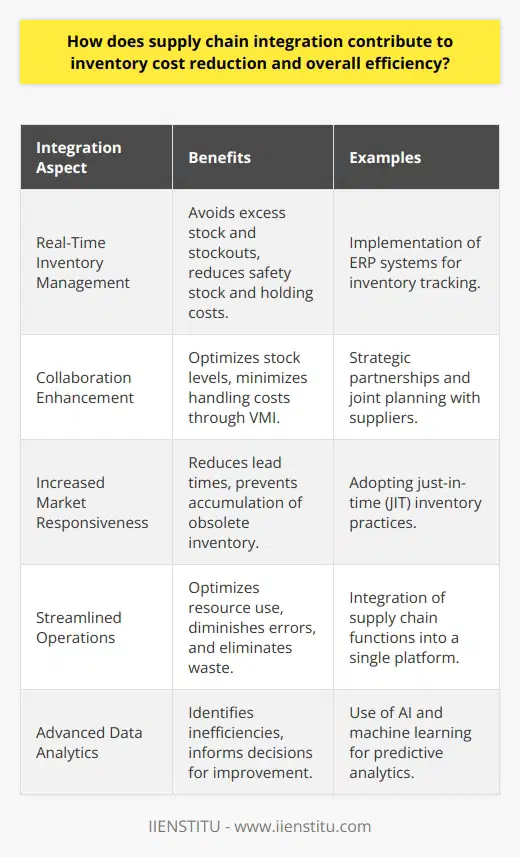
What is the impact of demand forecasting accuracy on inventory costs in supply chain management?
Impact on Inventory Costs
Accurate demand forecasting is crucial in supply chain management as it directly affects inventory costs. When demand forecasting accuracy increases, inventory costs are significantly reduced due to various reasons explained below:
Optimized Stock Levels
One of the main advantages of accurate demand forecasting is that it allows for better management of stock levels. By predicting the right quantity of products required to meet customer demands, companies can avoid both overstocking and stock-outs, leading to lower carrying costs and storage expenses.
Safety Stock Reduction
When demand forecasting becomes more accurate, supply chain managers can reduce the amount of safety stock maintained to cover unpredictable fluctuations in demand. Reduction in safety stock minimizes financial risk, inventory holding costs and frees up working capital for other business activities.
Improved Lead Time
Higher demand forecasting accuracy also improves lead time management. By understanding the expected demand, supply chain managers can engage suppliers more effectively and optimize lead times, reducing the need for excessive inventory buffers to compensate for delays. Timely deliveries further decrease the likelihood of stock-outs.
Reduced Obsolescence
With accurate demand forecasting, the possibility of products becoming obsolete is minimized. Companies can better manage the production and procurement of products, ensuring that inventory turnover rates are maintained at an optimal level, which reduces the costs associated with obsolete goods.
Efficient Replenishment Scheduling
An improved demand forecast helps in efficient replenishment schedule planning. Companies can optimize the frequency and size of orders, reducing both inventory holding costs and order processing expenses. This enhances the overall efficiency of the supply chain and lowers inventory costs.
In conclusion, demand forecasting accuracy plays a significant role in inventory cost reduction within supply chain management. By optimizing stock levels, reducing safety stock, improving lead time, preventing obsolescence, and enhancing replenishment scheduling, companies can achieve considerable cost savings. This leads to improved operational efficiency, competitive advantage, and increased profitability.
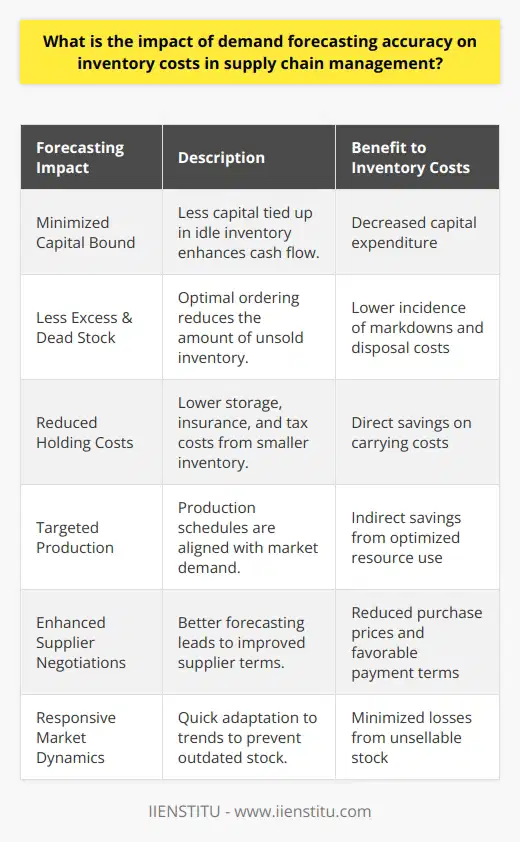
How can emerging technologies, such as artificial intelligence and machine learning, help improve inventory management and reduce costs within the supply chain?
Enhanced Forecasting and Demand Planning
Emerging technologies, specifically artificial intelligence (AI) and machine learning, can streamline inventory management and minimize costs in the supply chain. First, AI tools can enhance forecasting and demand planning. By analyzing past sales data, customer buying behavior, and external factors, such as seasonal trends and market fluctuations, AI algorithms can predict future demand accurately. Accurate forecasts reduce excess inventory and stock-out situations, thereby decreasing costs by optimizing warehouse space and improving customer satisfaction.
Improved Inventory and Order Management
Second, machine learning models can optimize real-time inventory tracking and order management. By continuously updating stock levels and tracking order status, these models enable companies to identify discrepancies in stock levels and order fulfillment. This real-time tracking minimizes human error and ensures that products are always available for customers. Consequently, companies can make informed decisions about reordering and allocation of resources, avoiding unnecessary expenses.
Automation and Robotics in Warehouses
Additionally, AI technologies can be employed to automate various warehouse tasks, such as sorting, packing, and picking of items. Robotics powered by AI systems can perform these tasks efficiently, reducing the time and labor required for the process. This automation leads to cost reduction in the form of reduced labor costs, increased productivity, and decreased error rates. Moreover, AI-powered robotics allows for flexible operations during peak seasons, eliminating the need for temporary labor.
Data-Driven Decision Making
Lastly, AI and machine learning can assist companies in making data-driven decisions for inventory management. By analyzing a wide range of data sources, AI algorithms can identify inefficiencies and vulnerabilities in the supply chain. Through this analysis, companies can optimize inventory levels, reduce lead times, and enhance supplier relationships. This data-driven approach not only improves inventory management efficiency but also translates to financial savings in the long run.
In conclusion, the integration of AI and machine learning technologies can significantly contribute to optimizing inventory management and reducing costs within the supply chain. Enhanced forecasting, improved inventory tracking, automation, and data-driven decision-making are just a few avenues through which these technologies can revolutionize supply chain management. By adopting these innovations, companies can stay ahead of the competition and ensure long-term growth and sustainability.
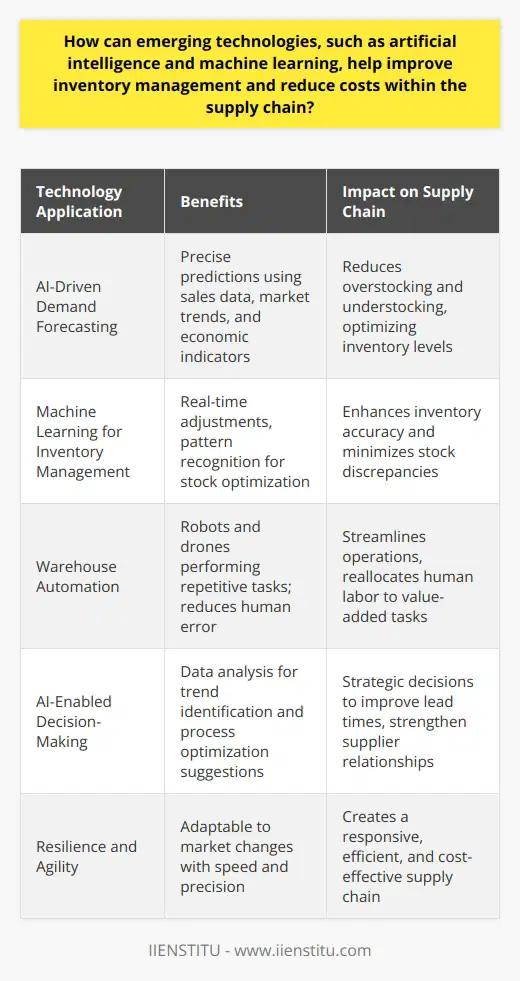
What are the benefits and drawbacks of implementing just-in-time inventory strategies in supply chain management to reduce inventory costs?
Benefits of Just-in-Time Inventory Strategies
Improved Cash Flow
Implementing just-in-time (JIT) inventory strategies allows companies to reduce inventory holding costs and improve cash flow. By ordering inventory only when needed, organizations can minimize the amount of capital tied up in inventory, freeing up cash for other business operations.
Reduced Storage Costs
With the reduction in inventory levels, companies following JIT strategies can also benefit from smaller warehouse requirements and lower storage costs. This further contributes to a leaner supply chain, where companies can save on long-term storage expenses and reallocate the saved resources to other growth opportunities.
Enhanced Quality Control
JIT inventory strategies foster continuous improvement and a focus on quality, as suppliers must be highly responsive and capable of delivering defect-free products. This enhanced collaboration between suppliers and manufacturers encourages a shared responsibility for quality, ultimately resulting in improved production processes and enhanced product quality.
Drawbacks of Just-in-Time Inventory Strategies
Reliability on Suppliers
One of the major drawbacks of JIT inventory strategies is the heavy reliance on suppliers. Suppliers must deliver goods quickly and reliably, which may lead to increased delivery costs and risk of disruption if suppliers fail to meet deadlines or experience issues in their production process.
Vulnerability to Supply Chain Disruptions
JIT inventory strategies make supply chains more vulnerable to disruptions, as there is no 'buffer' of stock to keep the production process moving. Any delays or interruptions in the supply chain can impact production and service levels, potentially damaging customer relationships and causing potential financial losses.
Lack of Flexibility
In industries with rapid changes and fluctuations in demand, JIT inventory strategies may struggle to adapt as quickly. As JIT systems rely on precise and accurate forecasts, unexpected shifts in customer demand can cause delays in the supply chain and negatively affect overall business performance.
In conclusion, just-in-time inventory strategies in supply chain management can significantly reduce inventory costs, improve cash flow, and enhance product quality. However, the benefits may be offset by the increased reliance on suppliers, vulnerability to supply chain disruptions, and lack of flexibility in the face of rapid market changes. Companies need to weigh the pros and cons of JIT strategies to ensure they strike the right balance between efficiency and resilience in their supply chain operations.
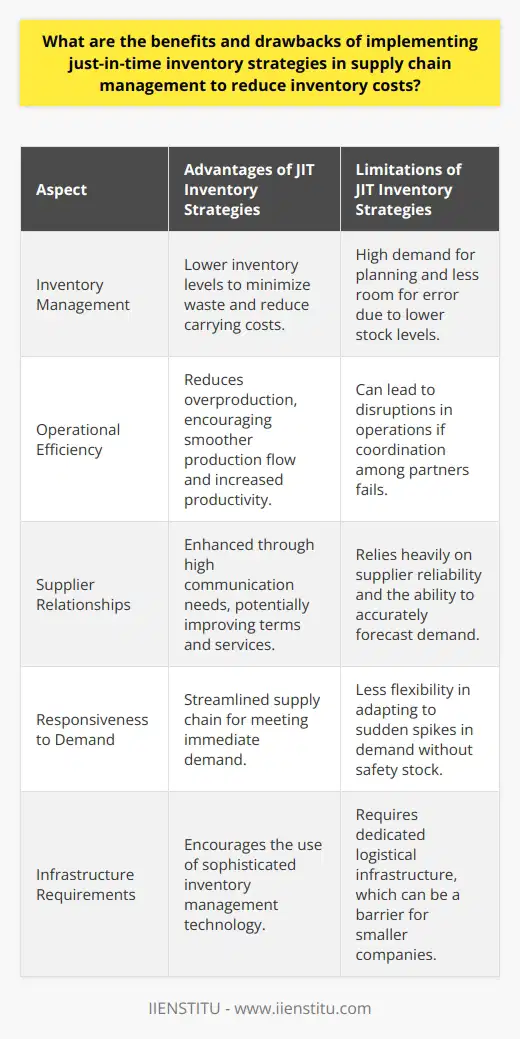
What are some strategies for effective demand forecasting to mitigate hidden costs in supply chain management?
Demand Forecasting Techniques
Effective demand forecasting is instrumental in minimizing hidden costs in supply chain management. One key aspect is using historical sales data. Frequent and meticulous analysis of prior sales can predict future demands accurately.
Incorporating Market Intelligence
Companies can also use market intelligence. This involves researching competitors, market trends, and consumer behavior to predict upcoming demand. Expert suggestions and insightful market analysis can provide valuable data.
Consideration of External Factors
External factors too impact demand forecasting. These include factors such as economic conditions or industry trends. Understanding such influences may help to better predict market demand. Additionally, monitoring these changes can prevent sudden stock issues, reducing supply chain costs.
Implementing Economic Indicators
A less known strategy is utilizing economic indicators. Key economic indicators, such as GDP and unemployment rates, can indicate possible fluctuations in demand. Keeping abreast of these changes can allow for advanced preparation, reducing unexpected expenses.
Use of Technological Tools
Lastly, several technological tools can aid demand forecasting. Tools such as machine learning and artificial intelligence can analyze extensive data sets and predict consumer demand with impressive accuracy. This technology-driven approach is especially relevant in the digital era and can significantly reduce hidden costs by improving forecasting accuracy.
To conclude, a combination of historical data analysis, market intelligence, consideration of external factors, use of economic indicators, and technological tools aid in robust demand forecasting. These strategies can mitigate hidden costs in supply chain management and optimize operation efficiency.
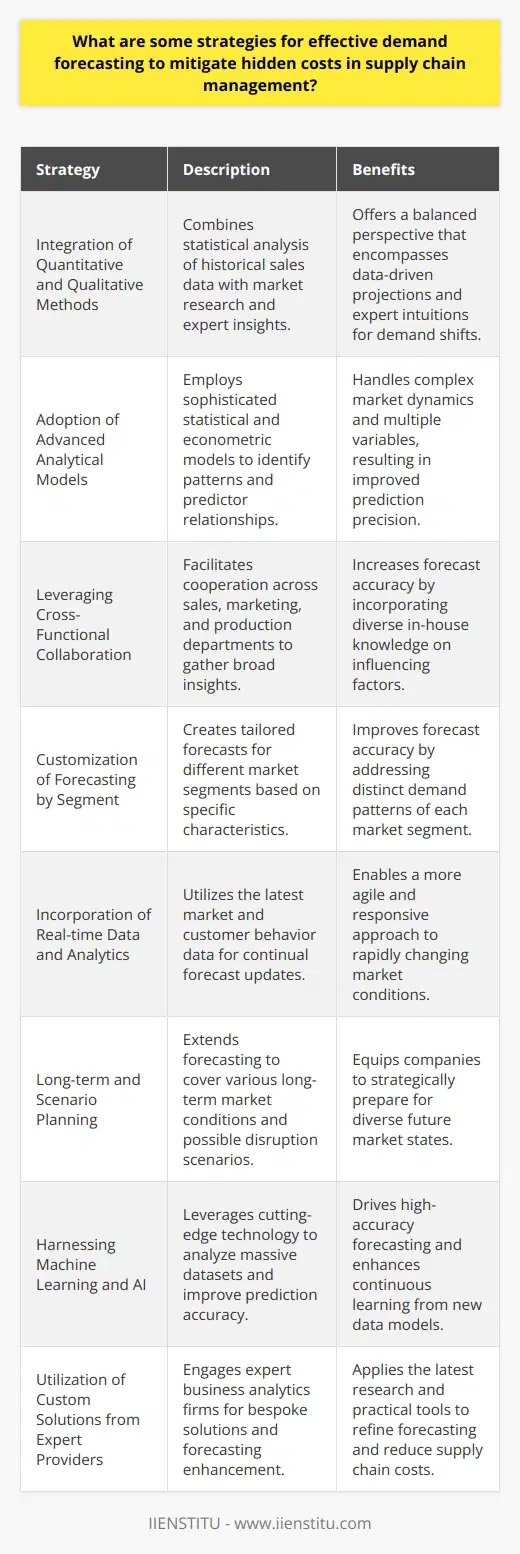
How do environmental and social factors contribute to hidden costs in the supply chain, particularly related to inventory management?
Environmental Factors
Environmental factors significantly contribute to hidden costs in supply chains, primarily concerning inventory management. Increased regulation and enforcement of environmental laws have raised the cost of compliance. This is particularly true in industries with high levels of emissions or waste production. These costs often manifest themselves indirectly, increasing warehousing and distribution costs. For example, maintaining controlled environments in storage facilities incurs additional energy costs.
Climate change also impacts the stability and predictability of supply chains. Extreme weather events can disrupt transport routes or damage stored goods. This unpredictability necessitates increased inventory levels to mitigate the risk of supply disruption, which drips down to the consumer in the form of higher prices.
Social Factors
Social factors, like labor practices and conditions, also contribute to hidden costs. Companies that neglect responsible labor practices may face reputational risks, leading to decreased demand or increased scrutiny. This may compel them to invest in improved conditions or fair labor practices, ultimately increasing the cost of goods.
Furthermore, societal shifts in consumer behavior can require adjustments in inventory management. Increasing consumer demand for sustainable products may need investment in different storage or transport methods, adding to costs. Lastly, cultural differences can lead to conflicts or misunderstandings in international supply chains, causing delays or inefficiencies.
In conclusion, both environmental and social factors lead to hidden costs in inventory management within supply chains. Firms should consider these factors when designing their supply chain systems and constructing cost models to ensure accurate forecasting and long-term profitability. Thank you.
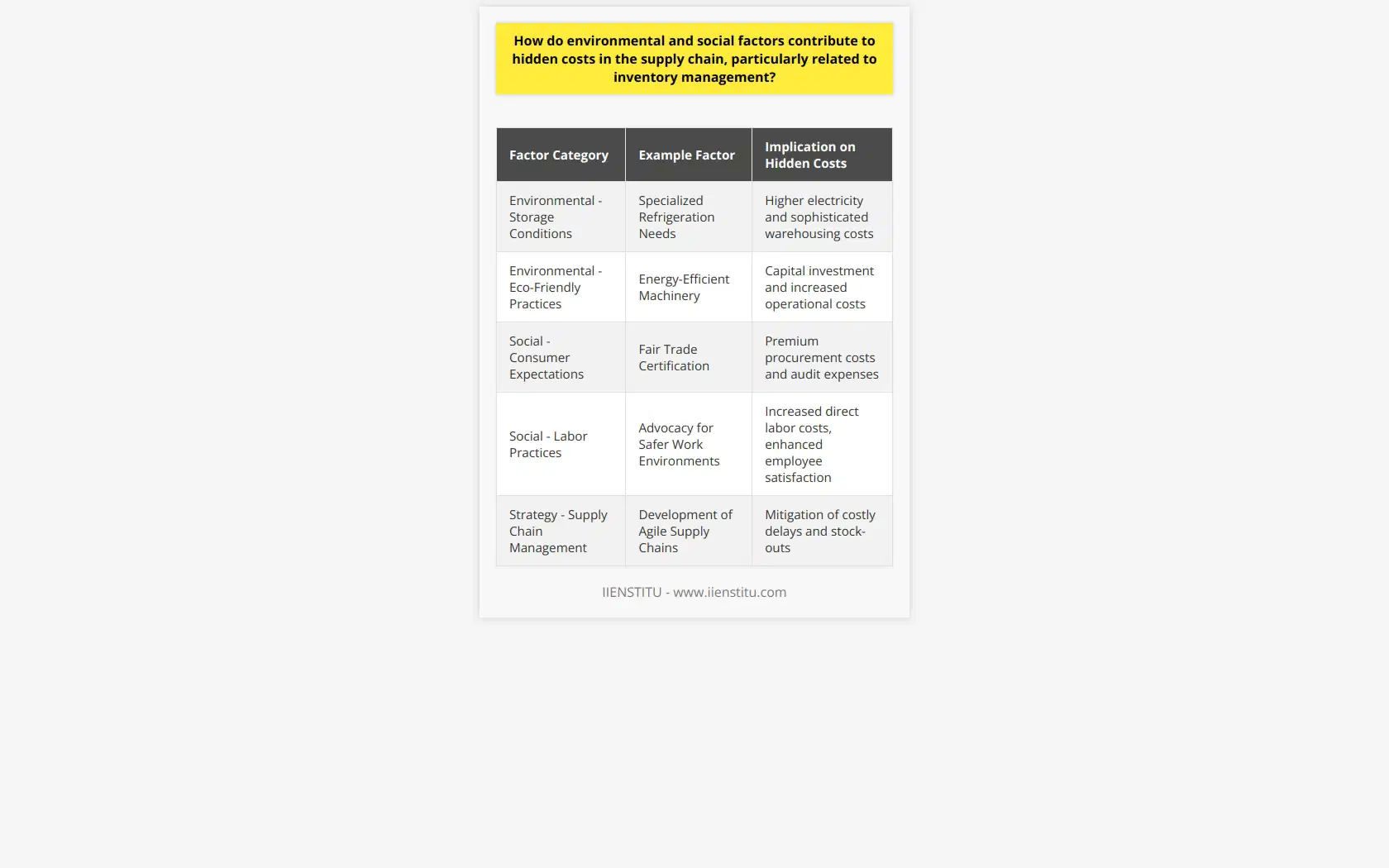
In what ways can collaboration and information sharing among various stakeholders in the supply chain lead to improved inventory management and reduced hidden costs?
Enhanced Information Exchange
Collaboration and information sharing among stakeholders in the supply chain positively impacts inventory management. When stakeholders share real-time data about inventory levels, the risk of overstocking or understocking reduces significantly. This exchange of information eliminates unnecessary holding costs and prevents stock-out situations leading to lost sales.
Improved Demand Forecasting
Information sharing can also lead to improved demand forecasting. With accurate data from different stakeholders, companies can predict customer demand more accurately. This accuracy prevents overproduction and surplus inventory, which are associated with considerable holding costs.
Cost Transparency
Collaboration brings about cost transparency in the supply chain. When each stakeholder is aware of the costs involved in various stages of the supply chain, they can work together to identify and eliminate unnecessary expenses. This collective effort results in reduced hidden costs.
Richer Supplier Relationships
Strong collaboration practices enhances the supplier-buyer relationship. Trustworthiness builds, allowing suppliers to plan their production cycles better. This mutual benefit alleviates rushed or delayed orders, reducing costs incurred due to inefficiencies.
Reduced Lead Time
Effective collaboration can decrease order lead time. With shared information, suppliers can anticipate demand and prepare in advance. Reducing lead time means less reliance on safety stock, lowering the carrying cost of inventory.
Overall, collaboration and information sharing among supply chain stakeholders plays a crucial role in improving inventory management and reducing hidden costs. This collective approach promotes efficiency, cost savings and robust managerial decisions.
